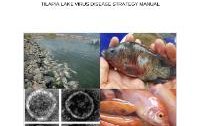The purpose of the FAO’s Tilapia lake virus disease strategy manual is to inform national policymakers and other stakeholders of issues related to the development of contingency plans for responding to outbreaks of tilapia lake virus disease (TiLVD), which has caused substantial mortalities, up to 90%, in populations of both wild and farmed tilapia in Asia, the Americas, and Africa. The causative agent for this disease is tilapia lake virus (TiLV), which infects the liver, spleen, kidney, heart, gill tissues, brain, connective tissues of muscle, and reproductive organs of tilapia.
Outbreaks of TiLVD not only have devastating economic effects on producers but can also result in a variety of socio-economic impacts on surrounding communities. It would, therefore, be prudent to implement strategies for the prevention of TiLVD and to develop contingency plans to eradicate, contain, and mitigate the impacts of the disease when outbreaks occur. This manual provides information on: 1) the nature of TiLVD; 2) diagnosis; 3) prevention and control; 4) epidemiology; 5) principles of eradication, containment and mitigation; and 6) policy development issues.
Tang, K.F.J., Bondad-Reantaso, M.G., Surachetpong, W., Dong, H.T., Fejzic, N., Wang, Q., Wajsbrot, N. & Hao, B. 2021. Tilapia lake virus disease strategy manual. FAO Fisheries and Aquaculture Circular No. 1220. Rome, FAO.
Download the manual here.









